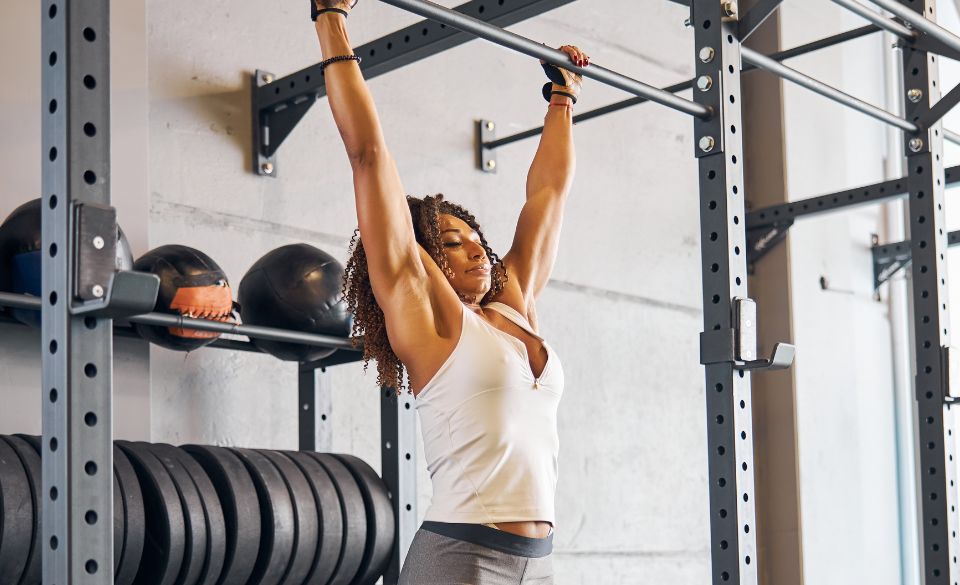
Dead Hangs: The Simple Exercise with Surprising Benefits
Page Contents
Dead hangs are a simple exercise that involves hanging from a bar or other sturdy object for an extended period of time. While this exercise may seem straightforward, it offers a variety of benefits for strength, flexibility, and overall fitness. In this article, we’ll explore the benefits of dead hangs and how to incorporate them into your fitness routine.
What are Dead Hangs?
Dead hangs are a simple and effective exercise that involves hanging from a bar or other sturdy object for an extended period of time. This exercise requires no equipment or special training and can be performed almost anywhere, making it a popular choice for people of all fitness levels.
Dead hangs offer a variety of benefits for strength, flexibility, and overall fitness. The exercise is an effective way to improve grip strength, as the weight of your body forces your hands and forearms to support your entire body weight. Dead hangs can also improve shoulder and back flexibility, as the weight of your body can help to stretch the muscles and ligaments in these areas. Additionally, dead hangs are an effective way to improve core strength, as you must engage your core muscles to maintain stability and prevent swinging.
Dead hangs can be incorporated into your fitness routine in a variety of ways. They can be performed as timed holds, where you hang from a bar for as long as possible, or as repetitions, where you perform multiple sets of dead hangs for a specific number of repetitions. You can also experiment with different hand positions, such as a wider or narrower grip, to target different muscle groups.
Benefits of Dead Hangs
Below are some of the benefits of dead hangs, supported by scientific studies.
Improved Grip Strength
Dead hangs are an effective way to improve grip strength. A study published in the Journal of Strength and Conditioning Research found that grip strength improved significantly in athletes who performed dead hangs for six weeks compared to those who did not. The weight of your body forces your hands and forearms to support your entire body weight, which over time can lead to improved grip strength and endurance.
Increased Shoulder and Back Flexibility
Dead hangs can help to increase flexibility in the shoulders and back. A study published in the International Journal of Sports Physical Therapy found that stretching exercises, including hanging from a bar, were effective in improving shoulder range of motion in individuals with shoulder impingement. The weight of your body can help to stretch the muscles and ligaments in the shoulders and back, improving range of motion.
Improved Core Strength
Dead hangs are also an effective way to improve core strength. When hanging from a bar, you must engage your core muscles to maintain stability and prevent swinging. A study published in the Journal of Athletic Training found that hanging exercises, including dead hangs, were effective in improving core strength in collegiate athletes.
Relief of Spinal Compression
Hanging from a bar can help to decompress the spine, which can provide relief for individuals who experience spinal compression. A study published in the Journal of Back and Musculoskeletal Rehabilitation found that hanging exercises were effective in reducing spinal compression in individuals with chronic low back pain.
Improved Posture
Dead hangs can also help to improve posture by strengthening the muscles that support the spine. By engaging the muscles in the back and core, dead hangs can help to improve spinal alignment and reduce the risk of poor posture and related injuries.
In summary, dead hangs offer a range of benefits for strength, flexibility, and overall fitness. Whether you’re a beginner or a seasoned athlete, incorporating dead hangs into your fitness routine can help to improve grip strength, increase shoulder and back flexibility, improve core strength, relieve spinal compression, and improve posture.
What Muscles Do Dead Hangs Strengthen
Dead hangs are a simple and effective exercise that can strengthen a variety of muscles in the upper body, including the back, shoulders, forearms, and core. Below are some of the muscles that are strengthened by dead hangs:
Latissimus Dorsi (Lats)
The lats are large muscles in the back that are responsible for pulling movements, such as pull-ups and rows. Dead hangs engage the lats by requiring them to support the weight of the body, which can help to strengthen and tone these muscles.
Trapezius (Traps)
The traps are muscles in the upper back and neck that are responsible for shoulder and neck movement. Dead hangs engage the traps by requiring them to stabilize the shoulders and support the weight of the body.
Forearms
The forearms are responsible for grip strength and endurance, and are heavily engaged during dead hangs. Supporting the weight of the body with the hands requires a strong grip, which can help to strengthen the muscles in the forearms.
Shoulders
The shoulders are engaged during dead hangs as the body weight pulls down on the shoulder joints, requiring the muscles in the shoulders to stabilize and support the weight of the body. This can help to strengthen and tone the muscles in the shoulders, including the deltoids and rotator cuff muscles.
Core
The core muscles, including the abdominal and back muscles, are engaged during dead hangs to stabilize the body and prevent swinging. This can help to strengthen and tone the core muscles, improving overall stability and posture.
How to Incorporate Dead Hangs into Your Fitness Routine
Incorporating dead hangs into your fitness routine is a simple and effective way to improve grip strength, increase flexibility, and improve overall fitness. Here are some tips on how to incorporate dead hangs into your fitness routine:
Start Slowly
If you’re new to dead hangs, start slowly and gradually build up your endurance. Begin by hanging for 10-15 seconds at a time, and then gradually increase the time you hang by a few seconds each session. It’s important to listen to your body and not push yourself too hard, as overexertion can lead to injury.
Vary Your Grip
Experiment with different hand positions, such as a wider or narrower grip, to target different muscle groups. Varying your grip can also help to prevent boredom and keep your workouts interesting.
Incorporate Dead Hangs into Your Warm-up or Cool-down
Incorporating dead hangs into your warm-up or cool-down routine can help to improve flexibility and reduce the risk of injury. Try hanging for 30-60 seconds before or after your workout to stretch your shoulders and back.
Perform Timed Holds
Performing timed holds is a great way to increase endurance and improve grip strength. Set a timer and hang for as long as possible, then gradually increase the time you hang over time. Aim to hang for at least 1-2 minutes at a time.
Incorporate Dead Hangs into Your Strength Training
Dead hangs can be incorporated into your strength training routine as a way to improve grip strength and target the muscles in the back and shoulders. Try performing dead hangs as part of a circuit, or as a warm-up exercise before lifting weights.
Final Words
Dead hangs are a simple exercise with a variety of benefits for strength, flexibility, and overall fitness. By incorporating dead hangs into your fitness routine, you can improve grip strength, increase shoulder and back flexibility, and improve core strength. Whether you’re a seasoned athlete or just starting out, dead hangs are a valuable addition to any fitness program.



